Landscaping for Wildlife – Part 4
December 9, 2013
Room to Grow
With this article we’ve reached Part 4 of our series on Landscaping for Wildlife. Our final topic is on providing the necessary habitat for wildlife to bear and raise their offspring. This involves strategies so that both adults and young can be safe from predators, weather and human curiosity (or vandalism). Your wildlife habitat needs to be a sanctuary where the entire life-cycle of the animal can take place. This may not be feasible with all wildlife that visits your garden or property, but it shouldn’t be an issue with birds, butterflies and moths, other insects, reptiles and amphibians. 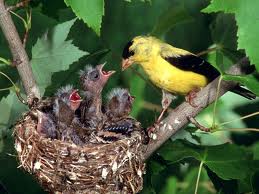
 In the American River canyon near where I live we have quite a number of California Pipevine (Aristolochia californica) plants growing into the live oak and Douglas-fir that cover the north-facing slopes. These vines are the host plant for the Pipevine Swallowtail (Battus philenor). To provide a food source for the larvae I have purchased and planted four of these vines in my new “native garden” area of the landscape. With spring I hope to see these new plants establish themselves and grow into the oaks, attracting the adult butterflies and creating a new habitat for these beautiful creatures.
In the American River canyon near where I live we have quite a number of California Pipevine (Aristolochia californica) plants growing into the live oak and Douglas-fir that cover the north-facing slopes. These vines are the host plant for the Pipevine Swallowtail (Battus philenor). To provide a food source for the larvae I have purchased and planted four of these vines in my new “native garden” area of the landscape. With spring I hope to see these new plants establish themselves and grow into the oaks, attracting the adult butterflies and creating a new habitat for these beautiful creatures.
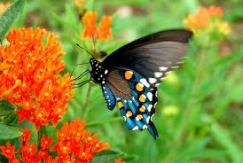 I have done the same by growing a couple of different species of the perennial Asclepias, common name being milkweed. The milkweed is a host plant for the Monarch butterfly, and since I see them here on occasion I‘ve decided to provide this source for both adult and larvae. Once you get to know the butterflies that live in your geographic area then you’ll be able to select the proper plants that will be that source of nectar for the adults and a food source for the caterpillars. Typically these will be native plants since that is what the insects have evolved with.
I have done the same by growing a couple of different species of the perennial Asclepias, common name being milkweed. The milkweed is a host plant for the Monarch butterfly, and since I see them here on occasion I‘ve decided to provide this source for both adult and larvae. Once you get to know the butterflies that live in your geographic area then you’ll be able to select the proper plants that will be that source of nectar for the adults and a food source for the caterpillars. Typically these will be native plants since that is what the insects have evolved with.
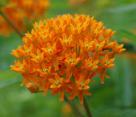
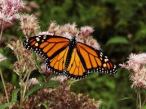 I have done the same by slowly constructing water features that are accessible for frogs, toads and dragonflies. We have large areas of ground cover that the toads hide in and hunt through, thus we have provided food, water, shelter and ponds for the young; everything that is needed to sustain the population.
I have done the same by slowly constructing water features that are accessible for frogs, toads and dragonflies. We have large areas of ground cover that the toads hide in and hunt through, thus we have provided food, water, shelter and ponds for the young; everything that is needed to sustain the population.
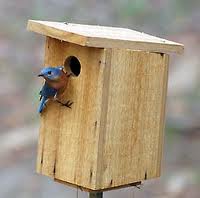 Birds may nest in nesting boxes, cavities in trees or on the ground in protected locations. Ground nesting birds don’t have enough space on our property to be safe, but birds that will nest in boxes or in trees do have ample places to call home. Be aware that different species of birds will nest at varying elevations above the ground, will prefer a nest box with a certain diameter of entry hole and may even want the box to face south for the warmth of the sun. Get to know the birds that spend spring and summer in your area and the types of terrain they frequent. Bluebirds eat insects and prefer open fields and meadows. Since we have a small open meadow we’ve been fortunate to have nesting bluebirds on the property. We’ve also watched families of nuthatch, wren and acorn woodpecker raise families here. The first two in nest boxes and the woodpecker in a cavity of the large valley oak (Quercus lobata) that grows near the house (the oak is 7 feet in diameter at chest height).
Birds may nest in nesting boxes, cavities in trees or on the ground in protected locations. Ground nesting birds don’t have enough space on our property to be safe, but birds that will nest in boxes or in trees do have ample places to call home. Be aware that different species of birds will nest at varying elevations above the ground, will prefer a nest box with a certain diameter of entry hole and may even want the box to face south for the warmth of the sun. Get to know the birds that spend spring and summer in your area and the types of terrain they frequent. Bluebirds eat insects and prefer open fields and meadows. Since we have a small open meadow we’ve been fortunate to have nesting bluebirds on the property. We’ve also watched families of nuthatch, wren and acorn woodpecker raise families here. The first two in nest boxes and the woodpecker in a cavity of the large valley oak (Quercus lobata) that grows near the house (the oak is 7 feet in diameter at chest height). 
While they do not nest on the property, gray tree squirrels are frequent visitors.
Bats will use the bat house to raise their young, so finding a good location for a few bat houses can give these small mammals a nesting site and in turn help with reducing the mosquito (and other flying insect) population around your yard.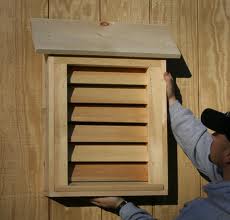
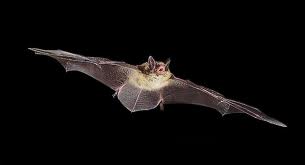 If your property is large enough you may consider building a brush shelter that will attract chipmunks, lizards, toads and more – a large variety of wildlife. By constructing a dense and heavy brush shelter you’ll probably attract many different animals that don’t feel comfortable in open meadows or polished landscaped gardens.
If your property is large enough you may consider building a brush shelter that will attract chipmunks, lizards, toads and more – a large variety of wildlife. By constructing a dense and heavy brush shelter you’ll probably attract many different animals that don’t feel comfortable in open meadows or polished landscaped gardens.
Place your brush shelter at the edge between tow native habitats – like on the edge between woodland and meadow. If available, use piles of stone along the edges of the brush and even on the interior – many animals like the stone to hide and nest in. Old metal or concrete pipe can be incorporated to act as tunnels for those that like that sort of thing.
To build a brush shelter, start with large logs – anywhere from 6 – 10 feet long and about 4 – 6 inches in diameter. Stack these in a criss-cross manner so that you create passages and spaces. After you have a strong base of 6 or more logs then add on branches in a tighter criss-cross weave and simply continue to add branches of smaller diameter in denser weave. The final product should be about 10 ft. square and about 4- 5 ft. high. Now sit back and see who comes to live there! 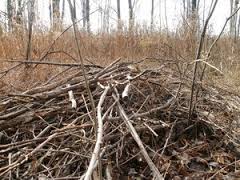
Lastly, maintain your garden in a way that reduces or (preferably) eliminates harmful chemicals from the landscape. Herbicides and pesticides will have a negative effect on all your efforts to create this wildlife sanctuary. Rather than burning fall leaves use them as mulch. Water will be conserved; the leaf mulch will provide homes for worms and insects and also reduces soil compaction while replenishing nutrients.
Look to using native plants whenever possible. Just because its native doesn’t mean that it is low water use – some natives thrive in streams and rivers. But many will do well in garden situations with less water, fertilizers and care than many of the more common variety of landscape plants you find in nurseries. Know the water use of the plant so that, if you’re irrigating, all the plants within that irrigation zone have the same water requirements.
If you’re going to be applying fertilizers then get a soils test first to know what your landscape actually needs, rather than simply throwing out 16-16-16 all over the garden in a shotgun approach! There are many alternatives to the petroleum-based fertilizers on the market today – organic fertilizers and amendments are readily available.
In the long run you’ll have a healthier landscape, a greater variety of wildlife and a safer environment for yourselves, your children and your pets.